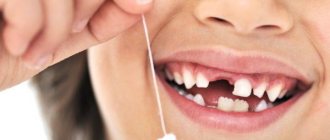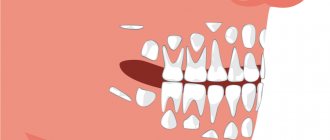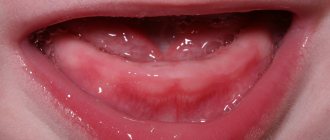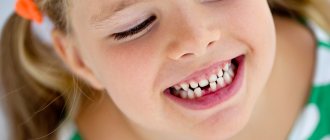Teething in an infant is a very exciting moment in the life of the baby and his parents. And although teething is a physiological process, almost all children experience discomfort and anxiety during this period. From the point of view of a scientific approach to this problem, the difficulty lies in the fact that with all the variety of teething symptoms from mild restlessness and moodiness, increased salivation to an increase in body temperature to high numbers and signs of impaired digestion, increased colic and diarrhea, there are no sufficient diagnostic criteria to connect all these numerous symptoms to the root cause. Nevertheless, many parents and some practicing pediatricians are still ready to blame the baby’s teething for almost all the troubles that befall them in the period from 5 - 6 months to one and a half - two years, when the teething process is mainly teeth should already be completed.
Most children begin teething between the ages of 4 and 7 months. As a rule, the eruption of each tooth lasts from 2 - 3 to 8 days. During this time, it is possible to increase body temperature to 37.4 - 38.0 degrees. At the same time, high temperature (from 38.0 and above) usually lasts no more than 2 days. Nasal discharge during the period when teeth are erupting is usually transparent, liquid, and should not contain pathological impurities: pus, greens, etc. Cough during teething is caused by saliva entering the nasopharynx and larynx area, which is released in large quantities. Cough due to teething does not require treatment. Regarding diarrhea, pediatricians sometimes differ in their opinions: some believe that diarrhea (loose stool) is not directly related to teething. And yet, studies have shown that from 10 to 30% of children have frequent and/or loose stools during teething. This is also explained by the large amount of saliva secreted, which enhances intestinal motility.
Teething or infectious disease
However, most modern pediatricians agree that such symptoms in an infant as: long-term, over 2-3 days diarrhea, cough, vomiting, fever (increase in body temperature above 38.5 degrees) are most often caused by infection, and not just teething teeth. Therefore, with any of the above symptoms, it is necessary to examine the child by a pediatrician, and only after other causes of increased body temperature have been excluded, efforts should be concentrated on helping the baby to reduce the discomfort from teething.
Timing of eruption of permanent teeth in children
Hurry up! Before the start of the summer holidays, there is a unique opportunity to take advantage of a 15% discount on pediatric dentistry!
Interactive dental formula
The timing of teething can characterize both the biological and passport age of the child. The process and timing of teething depend not only on inherited genetic parameters. The timing of teething can be influenced by external and internal factors (climatic conditions, diet, quality of drinking water, etc.). In this regard, the timing of the eruption of permanent teeth varies in different regions.
During a person’s life, 20 teeth change once, and the remaining 8-12 teeth do not change; they erupt initially as permanent teeth (molars).
By the age of three, all baby teeth erupt in a child, which by the age of 5 begin to gradually be replaced by permanent ones.
There are 20 primary teeth in total: on each jaw there are 4 incisors (4 central teeth), 2 canines (third teeth) and 4 molars (fourth and fifth teeth).
An adult normally has 28-32 permanent teeth: each jaw has 4 incisors, 2 canines, 4 premolars and 4-6 molars. The development of the third molar (“wisdom tooth”) may not occur at all (with congenital edentia of the third molars), which is also considered normal. Another situation is also possible: a wisdom tooth is embedded in the thickness of the jaw, but never erupts (due to incorrect position or lack of space in the jaw). This situation occurs very often.
After all the baby teeth have erupted, there are no gaps (gaps, gaps) between them, which is normal. But as the jaw grows, before the baby teeth are replaced by permanent ones, gaps should appear between the baby teeth. This process is necessary because permanent teeth are larger in size than baby teeth and if spaces are not formed, then the permanent teeth do not fit in the jaws and the child receives “crooked” permanent teeth.
In parallel with the formation of spaces between temporary teeth, the roots of baby teeth are “reabsorbed”, after which the teeth alternately become loose and fall out.
There is no general opinion about the normal timing of the eruption of permanent teeth, since scientific studies by different authors were carried out in different regions and in different years of the last and present centuries. Here are the norms for the eruption of permanent teeth according to several authors:
Central incisors 5-6 years (Vinogradova T.S. 1982) 6-8 years (Kolesov A.A. 1985) 7-8 years (Magid E.A. et al. 1987, Bykov V.L. 1998) 6- 9 years (Kalvelis D.A. 1994)
Lateral incisors 7-9 years (Vinogradova T.S. 1982) 8-9 years (Kolesov A.A. 1985, Magid E.A. et al. 1987, Bykov V.L. 1998) 7-10 years (Kalvelis D .A. 1994)
Fangs 12-13 years (Vinogradova T.S. 1982, Bykov V.L. 1998) 9-11 years (Kolesov A.A.1985) 10-13 years (Magid E.A. et al. 1987) 9-14 years (Kalvelis D.A. 1994)
First premolars 9-11 years (Vinogradova T.S. 1982, Bykov V.L. 1998) 9-10 years (Kolesov A.A. 1985, Magid E.A. et al. 1987) 9-13 years (Kalvelis D .A. 1994)
Second premolars 9-11 years (Vinogradova T.S. 1982) 11-12 years (Kolesov A.A. 1985, Magid E.A. et al. 1987, Bykov V.L. 1998) 10-14 years (Kalvelis D .A. 1994)
First molars 4.5 -7 years (Vinogradova T.S. 1982) 6 years (Kolesov A.A.1985) 5-6 years (Magid E.A. et al. 1987) 5-8 years (Kalvelis D.A. . 1994) 6-7 years (Bykov V.L. 1998)
Second molars 12-13 years (Vinogradova T.S. 1982, Kolesov A.A. 1985, Magid E.A. et al. 1987, Bykov V.L. 1998) 11-14 years (Kalvelis D.A. 1994)
Third molars (“wisdom teeth”) 18-25 years (Magid E.A. et al. 1987) 18-20 years (Kalvelis D.A. 1994) 18-30 years (Bykov V.L. 1998)
Here is the most common sequence of eruption of permanent teeth:
- First molars ("sixth teeth")
- Central incisors
- Lateral incisors
- First premolars ("fourth teeth")
- Canines (“eye teeth”) and/or second premolars (“fifth teeth”)
- Second molars ("seventh teeth")
- Third molars ("wisdom teeth")
Important! Each baby tooth is normally loosened and replaced with a permanent one.
Central primary incisor on the permanent one of the same name
Lateral primary incisor on the permanent one of the same name
Milk canine to permanent canine of the same name
First primary molar to first permanent premolar ("fourth tooth")
Second primary molar to second permanent premolar ("fifth tooth")
First permanent molar ("sixth tooth")
appears immediately permanent at 5-7 years.
Second permanent molar ("seventh tooth")
appears immediately permanent at 9-12 years of age.
Therefore, even if your child has not lost a single milk tooth at the age of 5-7 years, this does not mean that he does not have permanent molars (“sixth teeth”). The appearance of these teeth is not always accompanied by fever and general malaise.
Also, do not despair and panic if a child aged 5-7 years has a fever and is not eating well, perhaps his first molars are cutting!
A.I. Rarely dentist
2013
Teething: how to help your baby
This may require a fair amount of patience. During such a difficult period, you should take the baby in your arms more often, caress him, distract him from unpleasant sensations with toys, turn on pleasant, soothing music, and you can sing if natural abilities allow. A walk in the fresh air can also have a calming effect. Children who are breastfed, during teething, begin to cry more often and ask for the breast, and a loving mother needs to be patient, putting the baby to the breast every time, even if he grabs the nipple areola harder than usual during feeding. To satisfy the child’s need to chew something and hold something in his mouth, you can naturally use special rubber rings or toys, so-called teethers. You can offer your child dry food or baby cookies.
Currently, pharmaceutical companies offer a wide range of different products, primarily in the form of gels to “soothe the gums.” In general, most of these products contain painkillers such as lidocaine. You should not abuse these funds. They are not completely harmless; the anesthetics they contain can have an adverse effect on the child’s nervous and cardiovascular systems, and most importantly, they can cause serious allergic symptoms and contribute to the exacerbation of atopic dermatitis (diathesis) in children prone to allergies. In connection with the above, I can recommend, to reduce swelling and inflammation of the gums during teething, such special dental anti-inflammatory drugs for topical use as Cholisal gel, which can be applied to the baby’s gums 2-3 times a day, but must be rubbed in (not too much). of course) with light massaging movements over the entire surface of the gums, and not just putting it in the child’s mouth.
In addition, you can give a child suffering from teething special homeopathic drops, for example Dantinorm baby, according to the instructions for the drug. In any case, if the disturbing symptoms described above in this article appear, I advise you to play it safe once again and call a pediatrician to the home of a child with a high fever. A professional should give his diagnosis and recommendations.
In what order do teeth appear?
Usually baby teeth erupt in pairs. If, for example, the left central incisor appears, then after some time the right one begins to grow. In what order this happens does not matter.
Research shows that sometimes the eruption of baby teeth in infants occurs with a delay of one to two months, which may be due to a genetic factor, the mother’s health during pregnancy, climatic conditions, etc.
If the delay is longer than the specified period, we recommend showing the baby to a specialist.
We recommend that your child's first visit to the dentist be between the ages of six months and nine months. At the appointment, a specialist will conduct an examination and give recommendations on oral hygiene: which toothpastes and brushes are best to use, how to brush your teeth correctly.
Signs of changing baby teeth
Before the molars appear, a very interesting physiological process begins - the independent resorption of milk. At this time, the milk units become mobile and fall out. The rudiments of permanent teeth appear in the area of the roots of primary dental units. In this place, where the root is adjacent to the permanent tooth germ, the resorption process begins, which leads to the loss of the baby tooth.
The final release of the oral cavity from baby teeth occurs around the age of fourteen. This process occurs individually for everyone, so for some it ends earlier, for others later.
The process of loss of the milk and the appearance of the radical occurs simultaneously. Most often, the appearance of teeth and their loss occurs according to the following scheme:
- first the incisors;
- first molars;
- fangs.
The first molars appear a little later, despite the fact that they begin to grow long before the milk teeth fall out. Second molars appear only when the jaw grows and there is room for them. Third molars, called wisdom teeth, can appear at any age or may not grow at all.
What you should not do if your wisdom tooth is sick:
- Under no circumstances should you apply any heat to your cheek (including heating pads), or rinse your mouth with warm water. As a result of any warming, the infection can spread even more, even suppuration of the bone tissue is possible.
- It is not recommended to put painkillers on the tooth area, because as a result, not only will the pain not be relieved, but an ulcer may form on the gum.
- Under no circumstances should you use advice given by friends and relatives. This or that remedy can help them, but the exact cause and diagnosis are unknown, as a result of which your wisdom tooth is swollen.
What determines the symptoms of teething?
At what age do wisdom teeth erupt and what symptoms of this process depend on the individual characteristics and position in the jaw bone. The more abnormal the position, the more problematic it is. Impacted teeth (unerupted) cause particular inconvenience. They can grow at the wrong angle, put pressure on the “sevens”, and cause inflammation and bleeding of the gums. With such symptoms, the development of infection makes the situation worse. An unpleasant odor, shooting pain, and redness of the gums indicate active inflammation with the formation of pus. The situation is dangerous in terms of location, proximity to the brain and the possible development of complications.
Clinical picture of pericoronitis
The disease begins with increasing pain in the area of the wisdom tooth. The pain is very intense, it can radiate to the temple and ear. Pain may occur when opening the mouth, yawning, or swallowing. Sometimes you feel like your throat and cheek hurt, not your wisdom tooth. The process may also involve the facial muscles and lymph nodes. If a wisdom tooth becomes inflamed, the general condition of the whole body also suffers: a headache occurs and the temperature rises. The mucous membrane in the area of the diseased tooth is painful and red; as a result of “pressure” on the hood, pus may be released and swelling may occur.
Is it normal for a baby tooth to have not fallen out yet, but the molar tooth is already growing?
It also happens that a child’s teeth begin to grow “in two rows.” Many parents find this funny and are in no hurry to take their baby to the doctor, waiting until the baby tooth falls out on its own. And this is an erroneous position, which will only add to bite problems in the future.
As a rule, the molar, which grows under a tightly seated deciduous tooth, finds its exit in the gum from the side of the tongue. Incorrect position disrupts the bite. And the longer competitors fight for one place, the more crooked the permanent tooth will grow.
“Such cases are due to the anatomical features of the child’s oral cavity,” notes Victoria Arutyunova. — The permanent tooth is already growing, but the root of the milk tooth has not yet resolved. In this situation, you need to help the child get rid of the tooth, since, as practice shows, it cannot fall out on its own.”
When is it necessary to remove wisdom teeth?
Whether it is necessary to remove a wisdom tooth or not is the most common question that interests every person who is faced with the problematic eruption of “eights”. For wisdom tooth removal, as for any other surgical procedure, there are indications. Wisdom teeth are removed if:
- There are impacted “eights” - those that are incorrectly positioned in the jaw and cannot erupt, since they rest partially or completely on other teeth
- The “eight” has partially erupted, but there is pain and inflammation in the gums (recurrent pericoronitis).
- For pain along the trigeminal nerve.
- Presence of a mandibular cyst.
- Periodic pain in the area of the wisdom tooth, accompanied by headache, pain when swallowing or other painful conditions.
- Trauma to the oral mucosa as a result of improper tooth positioning.
What to do if your gums are inflamed
Contact your dental surgeon immediately. Before you plan to do this, you can take an anesthetic (ketorol, analgin, etc.) orally. It is advisable to rinse the oral cavity with a cold solution, which is prepared at the rate of 1 teaspoon of soda and the same amount of salt per glass of water.
Treatment of such a pathology consists of incision (opening) of the mucous “hood”, further washing of the cavity and taking anti-inflammatory and analgesic drugs. If a large amount of pus is removed during the autopsy, the patient must also take antibiotics. If the gums surrounding the wisdom tooth become inflamed again, then most often the dentist advises removing the wisdom tooth.
Caries
Carious lesions are another common problem that occurs during the eruption of wisdom teeth. The development of this pathology is due to the fact that the eighth teeth are located in a hard-to-reach place, which prevents good daily oral hygiene. Often, a wisdom tooth may erupt with initial signs of caries and damaged enamel. Due to the fact that such teeth are always pressed tightly against neighboring teeth, caries can quickly spread to them. In this case, after an examination, the dentist will decide whether the wisdom tooth can be treated or whether it is better to remove it.
Features of the structure and growth of “eights”
In general, the structure of these molars is not much different from the rest. They are characterized by the same crown and neck, but there are also some specific features in structure and growth:
- Structure and number of roots. Usually there are 4 of them, like most teeth, but there are also eights with 5 roots or, conversely, with one if they have fused in the embryo. Also, the roots of figure eights have a curved shape, which complicates their treatment.
- Location. Being the last ones, they are not sandwiched between adjacent molars, but since the jaw is already formed by the time they appear, there may not be enough space for them. It also causes inconvenience when cleaning them, so wisdom teeth are more susceptible to developing caries.
- Lack of milk precursor. For this reason, the process of teething and growth can be difficult and accompanied by pain.
- Lack of self-cleaning mechanism. This is due to their minimal participation in the chewing process.
Consequences of wisdom teeth removal
In almost all cases, removal of wisdom teeth is traumatic, which can result in slow healing and various complications. Pain after such a procedure may occur due to alveolitis, an inflammatory process in the socket. Normally, the hole is covered by a blood clot, which protects the wound from pathogenic microbes entering it. That is why it is strictly forbidden to rinse your mouth after tooth extraction! When a blood clot is washed out, an infection may develop or a dry socket may occur, which may require further surgery. In some cases, after removal of the “eight”, numbness of the tongue, chin or lip may occur in the first days. If this condition does not go away within a week, you need to consult a doctor again, who will prescribe the necessary treatment.
What to do?
If a breast crown falls out, there is no need to immediately run to the dentist. In order to reduce the risk of infection in the wound and eliminate negative consequences, the following steps must be taken:
- Immediately after the prolapse, it is necessary to form a tampon from cotton wool or medical gauze and place it on top of the hole. The child should lightly press it with his teeth and fix it in this position for 15 minutes .
During this period, a blood clot is formed in the socket cavity, which performs protective functions. As the hole becomes overgrown, it will disintegrate on its own.
- During the day, you can irrigate the wound with antiseptic drugs .
- In order to relieve swelling, it is recommended to take baths with a solution prepared from ½ teaspoon of salt .
- Before eating, to minimize pain, it is recommended to treat the edges of the wound with lidocaine-based dental gel . For children, a special drug called calgel .
- You should not give your child food within 2 hours after a tooth falls out.
- On the first day, you should avoid eating foods at borderline temperatures, as well as foods high in acids.
Do baby teeth need to be treated?
Caries is quite common in children at a very young age. To prevent caries, parents should pay special attention to their baby’s oral hygiene.
You need to treat caries in baby teeth! If caries is not treated, it can cause serious complications:
- early (unnatural) removal can lead to incorrect formation of a permanent tooth or to disruption of bite formation;
- violation of chewing function, which leads to the development of gastrointestinal pathologies;
- the development of pulpitis or periodontitis, which can provoke purulent inflammatory processes.











